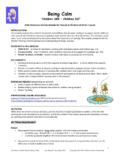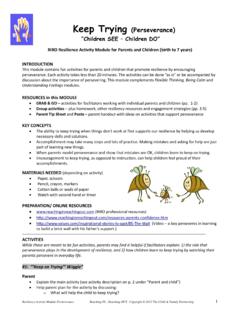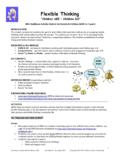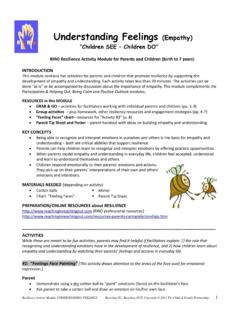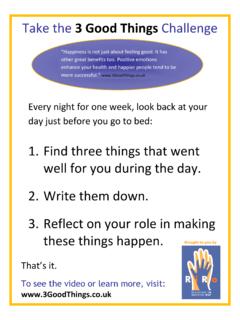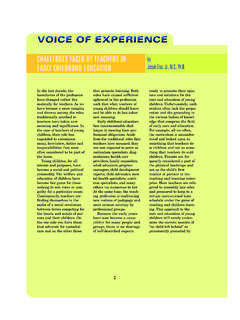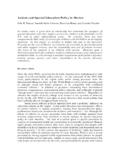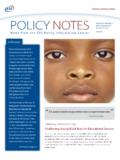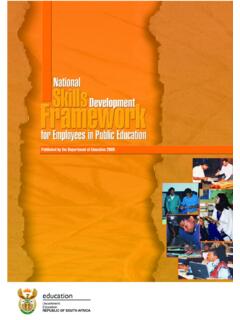Transcription of Introducing Thinking Skills to Promote Resilience …
1 RIRO Thinking Skills and Resilience 1 Introducing Thinking Skills to Promote Resilience in Young Children* Darlene Kordich Hall Jennifer Pearson Reaching OUT Project (RIRO) Child & Family Partnership Toronto, Ontario November 2004 [*An abridged version of this manuscript was published by the Child Welfare League of Canada in Canada s Children, 11 (3), 31 36. Permission has been given by the CWLC to include the full manuscript on this website.] RIRO Thinking Skills and Resilience 2 Introduction Resilience helps people steer through day-to-day stresses, overcome childhood disadvantage, bounce back from adversity and reach out to opportunities.
2 It can be defined as the ability to persevere and adapt when things go awry (Reivich & Shatt , 2002, p. 1). Thirty years of research tells us that resilient people are healthier, live longer, are more successful in school and jobs, are happier in relationships and are less prone to depression (Reivich & Shatt , 2002; Seligman, 1991; Werner & Smith, 2001). Stress and adversity are an inevitable part of life. It is important, therefore, to introduce children to resiliency-enhancing strategies at an early age. Resiliency promotion programs for young children have existed since the 1970's and have focused primarily on building self-esteem, increasing school readiness and supporting the parent-child relationship (Garmezy, 1991; Luthar & Ziegler, 1991; Werner, 1993).
3 Many promotion efforts, however, have overlooked the importance of Thinking processes in the development of Resilience , handling of stress and adversity, and prevention of depression (Reivich & Shatt , 2002; Shatt , Reivich, Gillham & Seligman, 1998). According to researchers at the University of Pennsylvania, Thinking processes directly affect several critical abilities associated with Resilience including emotional regulation, impulse control, causal analysis, empathy, self-efficacy, maintaining realistic optimism, and reaching out to others and opportunities (Reivich & Shatt , 2002).
4 Most of us have developed habitual ways of Thinking about stress and adversity thought processes that can either help or hinder our response to life s inevitable bumps in the road (Beck, 1976; Ellis, 1962; Seligman, 1991). Martin Seligman, a social psychologist at the University of Pennsylvania, focused on thought processes to produce his seminal work on learned helplessness. And later, he studied people s Thinking habits to inform his work on learned optimism. He found that the habitual way people explain why life events happen to them has an important impact on their ability to handle adversity and opportunity.
5 He referred to these Thinking habits as explanatory style (Seligman, 1991; Seligman & Teasdale, 1978). Explanatory style consists of three dimensions personalization, permanence and pervasiveness. These dimensions correspond to three questions people typically ask themselves when faced with stress, adversity, challenge and opportunity: 1. Who is responsible? 2. How long will it last? 3. How much of my life will it affect? Seligman and others have found that these Thinking habits are not immutable. People can learn to be more resilient by changing how they think about adversity and opportunity (Abela, 2003; Seligman, 1991; Stark et al.)
6 , 1998). Based on the work of Albert Ellis (1962) and Aaron Beck (1976), as well as more than 20 years of systematic research at the University of Pennsylvania, Seligman and his colleagues developed the Penn Resilience Program (PRP). The PRP trains teachers and children eight years and older in resiliency promotion and depression prevention Skills (Seligman, 1991; Shatt , Reivich, Gillham & Seligman, 1998). This evidence-based program is associated in the literature with depression prevention. Unlike most prevention programs, children at greatest risk RIRO Thinking Skills and Resilience 3were reported to benefit most from the PRP Skills training.
7 And, based on follow-up studies, the results appear to be long-lasting (Gillham & Reivich, 1999; Gillham, Reivich, Jaycox & Seligman, 1995; Jaycox, Reivich, Gillham & Seligman, 1994). Because their research has found that accurate and flexible Thinking is a hallmark of resilient people, the PRP uses a 12-session cognitive behavioral and social problem-solving approach to facilitate development of more accurate and flexible Thinking about life s adversities and opportunities (Reivich & Shatt , 2002; Seligman, Reivich, Jaycox & Gillham, 1995). Further support for the efficacy of PRP-type programs comes from other school-based intervention programs (Stark et al.)
8 , 1998). And, more recently, studies conducted by John Abela (2003) have found that while children of depressed parents were more likely to exhibit Thinking styles associated with depression, they could be trained to think in a more resilient way. These programs have shown success with children eight years and older, who are capable of meta cognition, but younger children are reportedly not developmentally able to think about their Thinking . However, research suggests that children as young as 2-1/2 to 3 years can mimic the Thinking styles of adults around them (Shatt , Reivich, Jaycox & Gillham, 1998).
9 So how do we introduce resilient Thinking Skills to younger children in order to influence their emerging Thinking styles? Seligman suggests this might be accomplished by helping young children to: (a) experience true mastery ( , where children see outcomes contingent upon their own actions); (b) gain a perspective of positivity (through authentic praise and identification of positive life experiences); and (c) experience positive explanatory styles modeled by adults around them (Seligman et al., 1995). Based on the body of research to date, the Child and Family Partnership1 decided to use the adult skill set from Penn Resilience Program school-age model to test whether it could be adapted for use with younger children by training adults to model resilient Thinking styles/ Skills in their everyday interactions with 2-1/2 6 year olds and to evaluate the outcome.
10 The pilot project, Reaching OUT (RIRO), evolved from the Partnership s effort, and the findings from the first stage of RIRO are the focus of this paper. The project s name comes from its goal to Promote Resilience by helping children reach in to think more flexibly and accurately and to reach out to others and opportunities. The following questions guided the testing of the PRP model in the RIRO project: 1. What is the impact of training adults working with young children in the PRP adult model? What is the impact of the Skills training on educators professionally and personally?


